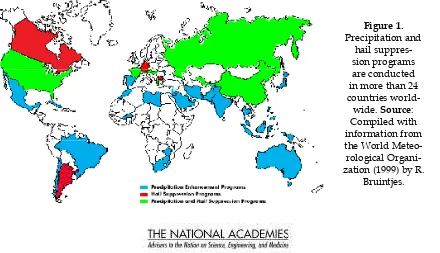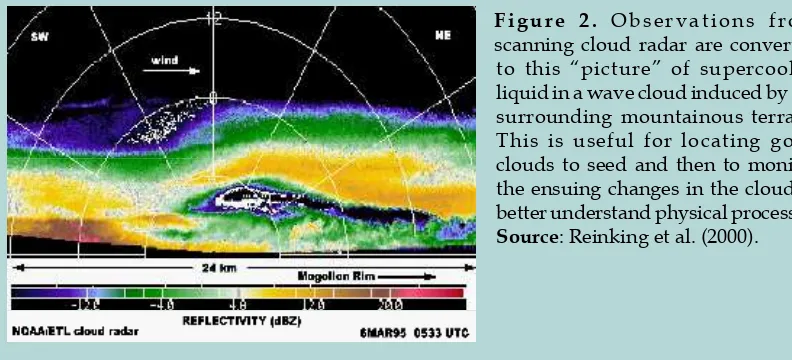C
ritiCal
i
ssues
in
W
eather
M
odifiCation
r
esearCh
figure 1. Precipitation and
hail suppres-sion programs are conducted in more than 24 countries world-wide. source: Compiled with information from the World Meteo-rological Organi-zation (1999) by R.
Bruintjes. The impact of human activity on weather and climate has been of increasing national and international concern over the past few decades. In stark contrast, there has been little parallel research directed at understanding the ability of humans to intentionally modify the weather. Yet the fundamental physical principles underlying both inadvertent and advertent weather modiication are, in many respects, the same.
In this same timeframe, remarkable progress has been made in our ability to observe atmospheric processes, record this information, and incorporate it into sophisticated mathematical models (see Box 1, p. 2). However, this power has not been collectively applied to the questions that can help us understand how or whether atmospheric systems can be intentionally changed.
At the same time, less than a handful of weather modiication research programs are underway worldwide, and related research in the United States has dropped to less than $500,000 per year from a high of $20 million in the late 1970s. Resolving this disparity between our willingness to attempt to modify weather and our willingness to conduct research to understand whether such activities can succeed will occur only if the relevant funding agencies and scientiic communities make a commitment to answer some of the fundamental underlying questions. The challenge is to ind the right balance between reducing scientiic uncertainties and the need for action to address pressing problems.
Box 1. advances in observational technologies
In the past, the only way to measure the moisture content and other characteristics of a cloud was to strap instrumentation onto a plane and ly it into the cloud. Measurements were therefore limited to path of the plane. The newest remote-sensing and in situ equipment—advanced by urgent needs in the areas of severe storm warnings, detection of aircraft icing conditions, and climate change—offers higher resolution “pictures” of clouds and cloud systems than ever before possible (see Figure 2).
These tools can now estimate in-cloud particle shapes and sizes, track the dispersion of seeding aerosols, and more accurately estimate precipitation. Millimeter-wave cloud radar can describe non-precipitating clouds. The national Doppler radar network (NEXRAD) provides opportunities for examining the evolution of radar signatures in all regions of the country and for applying cell tracking capabilities in ield experiments. Although they have been nominally used in cloud-seeding observations, these tools have not yet been used as integral components of experiments designed to test and evaluate speciic scientiic hypotheses in weather modiication.
f i g u r e 2 . O b s e r v a t i o n s f r o m scanning cloud radar are converted to this “picture” of supercooled liquid in a wave cloud induced by the surrounding mountainous terrain. This is useful for locating good clouds to seed and then to monitor the ensuing changes in the cloud to better understand physical processes. source: Reinking et al. (2000).
Critical uncertainties limiting advancement
Progress in obtaining answers to such questions depends on sustained and directed research in laboratories, on research centers dedicated to modeling, and on carefully designed and veriiable ield experiments equipped with the most advanced observing tools. Identifying and addressing these critical uncertainties will focus future research where it will produce the most useful results.
Call for a Coordinated national Program
A coordinated national program of weather modiication research designed to reduce key uncertainties is needed. This program should be the heart of a sustained research effort that uses a balanced approach of modeling, laboratory studies, and ield measurements. Instead of focusing on near-term operational applications of weather modiication, the program should address fundamental research questions that might include:
• What is the background aerosol concentration in various places, at different times of the year, and during different meteorological conditions? To what extent would weather modiication operations be dependent on these background concentrations?
Box 2. summary of Key uncertainties
Cloud/Precipitation Microphysics issues
highest priority: understand the background concentration, sizes, and chemical composition of aerosols that participate in cloud processes.
Other gaps: How nucleation processes relate to characteristics of aerosol particles; ice nucleation; Evolution of the droplet spectra in clouds; Relative importance of drizzle in precipitation processes.
Cloud dynamics issues
highest Priority: understand cloud-to-cloud and mesoscale interactions as they relate to updraft and downdraft structures and cloud evolution and lifetimes. Other gaps: Cloud and sub-cloud dynamical interactions as they relate to precipitation amounts and the size spectrum of hydrometeors; Microphysical, thermodynamical, and dynamical interactions within clouds.
Cloud Modeling issues
highest priority: Combination of the best cloud models with advanced observing systems in carefully designed ield tests and experiments.
Other gaps: Application of new cloud-resolving models to weather modiication, including short-term predictive models; Predictive models for severe weather events; Cloud models capability to track dispersion of seeding material both within and outside of seeded areas.
seeding-related issues
high priority: targeting of seeding agents, diffusion and transport of seeding material, and spread of seeding effects throughout the cloud volume.
high priority: Measurement capabilities and limitations of cell-tracking software, radar, and technologies to observe seeding effects.
this report brief was prepared by the national research Council based on the committee’s report. for more information, contact the National Research Council’s Board on Atmospheric Sciences and
Climate at 202-334-3512. Critical Issues in Weather Modiication Research is available from the National
Academies Press, 500 Fifth Street, NW, Washington, DC 20001; 800-624-6242 or 202-334-3313 (in the
Washington area); www.nap.edu.
Committee on the Status and Future Directions in U.S. Weather Modiication
research and operations: Michael Garstang (Chair), University Of Virginia, Charlottesville; roscoe r. Braham, Jr., North Carolina State University, Raleigh; roelof t. Bruintjes, National Center For Atmospheric Research, Boulder, Colorado; steven f. Clifford, University Of Colorado, Boulder; ross n. hoffman, Atmospheric & Environmental Research, Inc., Lexington, Massachusetts; douglas K. lilly, University
Of Oklahoma, Norman; Robert J. Serain, National Center For Atmospheric Research, Boulder, Colorado; Paul d. try, Science & Technology Corporation, Silver Spring, Maryland; Johannes Verlinde, Pennsylvania State University, University Park, Julie demuth (Research Associate), Board
on Atmospheric Sciences and Climate.
Copyright 2003 the national academies
• What is the variability of cloud and cell properties (including structure, intensity, evolution, and lifetime) within larger clusters, and how do clouds and cells interact with larger-scale systems? What are the effects of localized seeding on the larger systems in which the seeded clouds are embedded?
• How accurate are radar relectivity measurements in measuring the differences between accumulated rainfall in seeded and unseeded clouds? How does seeding affect the drop-size distribution that determines the relationship between the measured radar parameter and actual rainfall at the surface?
To take advantage of recent related research and advances in observational, computational, and statistical technologies, the program should attempt to:
• Capitalize on new remote and in situ observational tools to carry out exploratory and conirmatory experiments in a variety of cloud and storm systems
• Improve cloud model treatment of cloud and precipitation physics.
• Improve and use current computational and data assimilation capabilities. • Capitalize on existing ield facilities and develop partnerships among research
groups and select operational programs.
Thus, the initiation of large-scale operational weather modiication programs is premature, but a great opportunity exists to coordinate research efforts to address the fundamental questions that will lead to credible scientiic results. It is not enough to expand present efforts that primarily analyze data from largely uncontrolled experiments. Instead, focused investigation of atmospheric processes, coupled with an exploration of the technological applications, will certainly advance understanding and bring many unexpected beneits and results. In time, this research will place us in a position to determine whether, how, and to what extent weather and weather systems can be modiied.
Critical Issues in Weather Modiication Research is the National Academies latest assessment of weather

